Core-level processor lockstepping
a technology of core-level processors and lock steps, which is applied in the field of microprocessor design, can solve the problems of microprocessors and other silicon-based devices becoming increasingly susceptible to soft errors, devices malfunctioning, microprocessors to execute incorrect instructions or to act on incorrect data,
- Summary
- Abstract
- Description
- Claims
- Application Information
AI Technical Summary
Benefits of technology
Problems solved by technology
Method used
Image
Examples
Embodiment Construction
[0026]Referring to FIG. 1A, a block diagram is shown of a system 100 for operating multiple microprocessor cores 102a-b in lockstep according to one embodiment of the present invention. The cores 102a-b are components of a microprocessor 104, which may have additional cores (not shown in FIG. 1A for ease of illustration).
[0027]Cores 102a-b are coupled to ports 126a-b, respectively, of an on-chip crossbar 108. More specifically, core 102a outputs data / control signals to port 126a on line 114a and receives data signals from port 126a on line 118a. Similarly, core 102b outputs data / control signals to port 126b on line 114b and receives data signals from port 126b on line 118b.
[0028]The system 100 also includes lockstep logic 106, which is coupled to crossbar port 112. Lockstep logic 106 is coupled to data / control lines 114a-b and data lines 118a-b of cores 102a-b, through which the lockstep logic 106 may send and receive signals to and from the cores 102a-b.
[0029]The system 100 may o...
PUM
 Login to View More
Login to View More Abstract
Description
Claims
Application Information
 Login to View More
Login to View More - R&D
- Intellectual Property
- Life Sciences
- Materials
- Tech Scout
- Unparalleled Data Quality
- Higher Quality Content
- 60% Fewer Hallucinations
Browse by: Latest US Patents, China's latest patents, Technical Efficacy Thesaurus, Application Domain, Technology Topic, Popular Technical Reports.
© 2025 PatSnap. All rights reserved.Legal|Privacy policy|Modern Slavery Act Transparency Statement|Sitemap|About US| Contact US: help@patsnap.com



